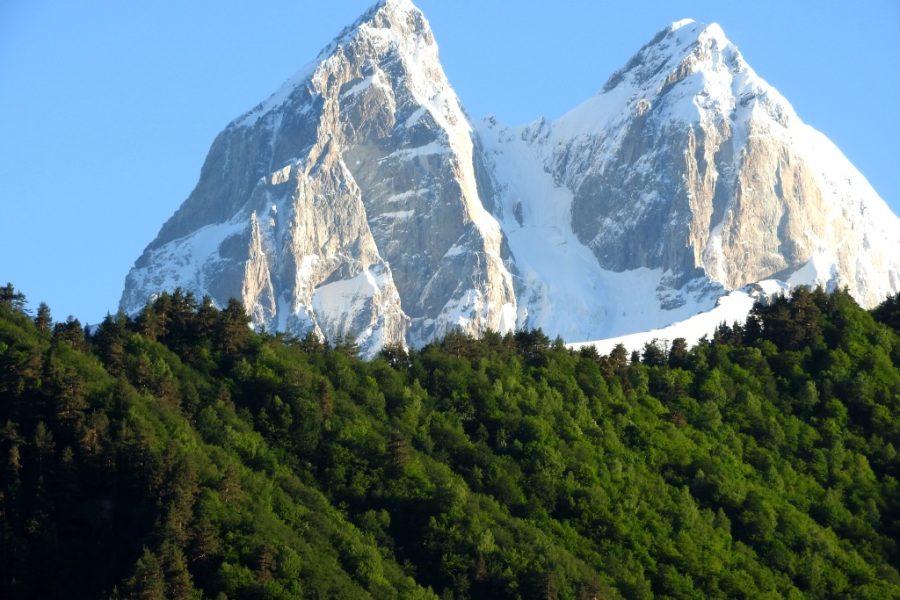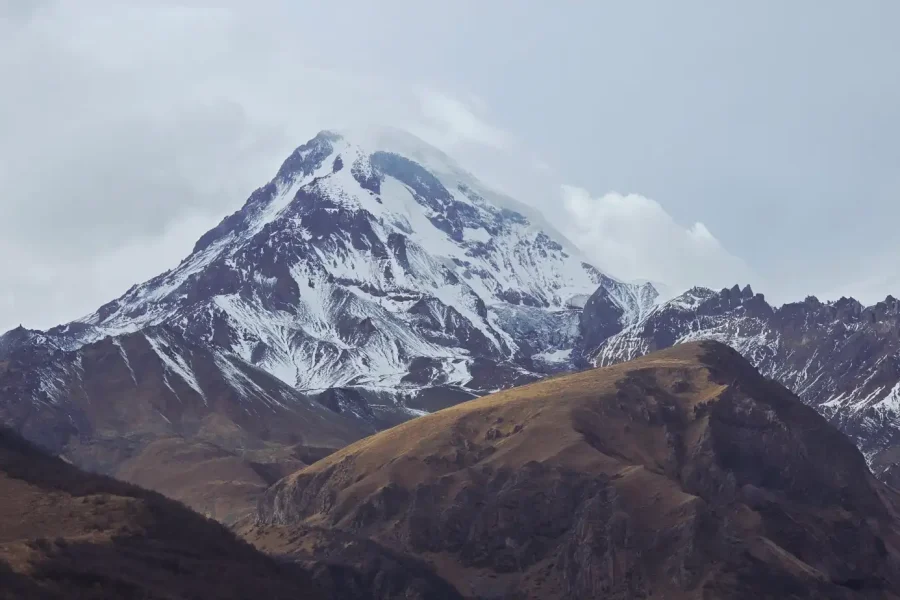Liakhvi State Nature Reserve: A Legacy in an Inaccessible Land
The Liakhvi State Nature Reserve (ლიახვის სახელმწიფო ნაკრძალი) is a protected area in the northern part of Georgia’s Shida Kartli region. Founded in 1977 during the Soviet era, its main goal was to protect the unique mountain ecosystems that can be found on the southern slopes of the Greater Caucasus mountains. In particular, it wanted to protect valuable forests, such as large stands of Caucasian Pine (Pinus kochiana or Sosnowsky’s Pine), as well as the many animals that live in this mountainous area.
The reserve is more than 6,000 hectares big and includes the upper parts of the Patara Liakhvi river valley. The landscape is mostly mountainous, with forested slopes, river valleys, and probably subalpine meadows at higher altitudes, which are between 1,200 and 2,300 meters or more above sea level. Many species that are common in the Caucasus, such as the Brown Bear, Wolf, Lynx, Roe Deer, and different mountain birds, may live in these forests. Keeping these forests safe also helps keep the Liakhvi River watershed healthy.
Important Note on Current Status
It is important to know that the Liakhvi State Nature Reserve is in an area of Georgia that is currently controlled by the Russian Federation (specifically in the Tskhinvali Region/South Ossetia). Because of this, the Georgian government and its Agency of Protected Areas don’t have good control over this area. This means that the Georgian government can’t manage the reserve, do conservation work, keep an eye on wildlife, or let visitors or researchers from Georgian-controlled areas in.
So, even though Georgian law says that Liakhvi State Nature Reserve is still a protected area, Georgian conservation groups don’t know much about its current condition, the state of its biodiversity, or how well the protection rules are being followed. There is no information available from the Georgian side about how to get to the reserve, possible trails, facilities, or any other visitor-related details because access from Georgian-controlled territory is currently blocked by the occupation line.
The reserve is an important part of Georgia’s natural heritage. It was created to protect certain ecosystems in the Caucasus. But the ongoing occupation makes it very hard to achieve its goals and manage it, which shows how political stability and environmental protection are linked. The future of the area depends a lot on how the conflict is resolved and Georgia’s ability to regain control over the land.
Reserve Overview at a Glance
Official Name:
Liakhvi State Nature Reserve (ლიახვის სახელმწიფო ნაკრძალი).
Protected Area Type:
State Nature Reserve (IUCN Category Ia: Strict Nature Reserve). This designation means the highest level of protection, mostly for scientific research and conservation, with very few human activities allowed.
Established:
Established in 1977.
Governing Body:
The Agency of Protected Areas (APA) of Georgia is in charge of it by law. But in reality, the APA can’t control or manage the reserve right now (as of April 2025) because Russia is occupying the Tskhinvali Region/South Ossetia.
Location and Inaccessibility
Location:
Georgia, Shida Kartli Region (historically part of the Java Municipality). The Patara Liakhvi River’s upper basin is on the southern slopes of the Greater Caucasus mountain range. The Russian Federation currently controls this area, which is very important.
Map/Coordinates:
The approximate center is at 42°23′ N Latitude and 44°07′ E Longitude. Because of the occupation, it may be hard to get accurate, up-to-date maps that show current conditions and borders.
Closest Towns (within occupied territory):
Tskhinvali is the main city in the occupied area. In the past, the administrative center of Java was closer.
How to Get There:
It is currently impossible to get to the Liakhvi State Nature Reserve from areas controlled by the Georgian central government because of the occupation line and lack of control. Georgian official channels don’t have any information about how to get to the occupied territory or any other route.
Landscape and Geography
Area:
About 6,388 hectares (63.88 km²).
Topography:
The area has mountains, river valleys, and forested mountainsides. The southern slopes of the Greater Caucasus range are also part of the area. The altitude is between 1,200 and 2,300 meters, but it could be higher.
Geology and Key Features:
The main parts of the Caucasus region’s geology are mountain slopes and valleys. Georgian institutions do not currently have access to or documentation of specific unique geological features for study.
Hydrology:
The reserve is mostly made up of the headwaters of the Patara Liakhvi River and its tributaries. It probably has streams and springs in the mountains.
Climate:
The altitude has a big effect on the mountain climate. The winters are usually cold and snowy, while the summers are cool.
Original Purpose and Significance
Reason for Designation:
The main goal of the designation was to protect the relatively untouched high-mountain forest ecosystems, especially valuable stands of Caucasian Pine (Pinus kochiana/sosnowskyi), and the animals that live in the central Greater Caucasus southern slopes. Also meant to protect the variety of life in the Liakhvi river headwaters.
Key Values:
Protecting unique Caucasian forest types, providing habitat for regional animals (including species that may be rare or only found in this area), allowing for scientific research (which is currently not possible for Georgian researchers), and protecting watersheds.
International Recognition:
The Caucasus biodiversity hotspot is part of the area, but certain international designations, such as Emerald Network Site or IBA under Georgian management, are not being used or confirmed because of the occupation.
Biodiversity: The Reserve’s Natural World
Ecosystems/Habitats:
The expected habitats are mountain forests (coniferous forests with Caucasian Pine, mixed forests with beech, oak, birch, and deciduous forests at lower elevations) and subalpine meadows at higher altitudes.
Key Plant Species:
Caucasian Pine (Pinus kochiana/sosnowskyi) is a protected species that is very important. In subalpine areas, other trees that might grow there are Oriental Beech, Oak species, Birch, Maple, and maybe Caucasian Rhododendron.
Key Animal Species:
Depending on the area and the types of habitats, some animals that could live there are the Brown Bear, Wolf, Lynx, Roe Deer, and Wild Boar. There may also be Caucasian Red Deer. Birds that live in the Caucasus mountain forests would be common.
Endangered/Rare Species:
Georgian law protects animals like the Brown Bear and Lynx. Georgian authorities can’t get to the reserve right now to check on the status of other species that might be rare or endangered, like the Caucasian Grouse.
Visitor Information: Access Not Possible
Visitor Centers:
None that Georgian authorities can get to or run.
Hours and Seasons:
Not applicable. Access is blocked from land controlled by Georgia.
Entrance Fees and Permits:
No entrance fees or permits are needed. Georgian authorities can’t handle or collect permits or fees.
Trails and Routes:
There is no information available about marked trails that are open or maintained by the Georgian government.
Activities:
Not applicable. The Georgian government can’t officially allow or plan any activities.
Accommodation:
Not applicable. Georgian channels don’t have any information about accommodation options related to the reserve.
Facilities:
Not relevant.
Safety Advice:
Not necessary. The Georgian government can’t give any safety advice because they don’t have access or control. Going into the occupied area is very dangerous.
Intended Rules and Current Status
Code of Conduct:
Because it is a Strict Nature Reserve, the rules would not allow people to go there for any reason other than scientific research. They would also not allow hunting, logging, fires, or any other activity that would disturb the ecosystem.
Prohibitions:
All of the usual rules for a Strict Nature Reserve were meant to be followed, such as no hunting, fishing, logging, collecting plants or animals, building, and so on.
Zoning:
The whole area is a Strict Nature Reserve.
Current Enforcement:
The Georgian government can’t enforce any laws or rules in the occupied area. We don’t know what the current state of enforcement is.
Conservation and Management Challenges
Managing Body:
The Agency of Protected Areas of Georgia is the legal management authority. This agency can’t manage anything right now because of the occupation.
Conservation Efforts:
Georgian institutions can’t start any conservation projects right now. We don’t know what the current state of conservation is.
Threats and Challenges:
The main problem is the Russian occupation, which stops Georgia from doing anything to manage or protect the area. Some possible threats are not enough management oversight, illegal logging or poaching, the military’s effects on the environment, and the effects of climate change not being watched.
Historical and Cultural Context
A Brief History:
The Georgian SSR government set it up in 1977. Since the 1990s conflicts and especially since the 2008 war, it has been marked by the lack of Georgian control.
Cultural Importance:
There are many historical and cultural sites in the area around Shida Kartli, especially in the Liakhvi valley. These include churches and fortresses. But it is hard for people in Georgian-controlled territory to get to sites in the occupied zone.
Interesting Facts About Liakhvi Reserve
Unique Features:
- The name was chosen to protect important groups of Caucasian Pine trees.
- The most important “unique feature” in this case is that it is in a part of Georgia that is controlled by Russia, which makes it impossible for management, research, and visits to take place there.





Leave a review